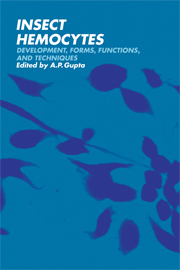Book contents
- Frontmatter
- Contents
- Preface
- List of contributors
- Part I Development and differentiation
- Part II Forms and structure
- 4 Hemocyte types: their structures, synonymies, interrelationships, and taxonomic significance
- 5 Surface and internal ultrastructure of hemocytes of some insects
- 6 Fine structure of hemocyte membranes and intercellular junctions formed during hemocyte encapsulation
- 7 Controversies about the coagulocyte
- 8 Controversies about hemocyte types in insects
- 9 Hemocyte cultures and insect hemocytology
- 10 Pathways and pitfalls in the classification and study of insect hemocytes
- Part III Functions
- Part IV Techniques
- Indexes
7 - Controversies about the coagulocyte
Published online by Cambridge University Press: 04 August 2010
- Frontmatter
- Contents
- Preface
- List of contributors
- Part I Development and differentiation
- Part II Forms and structure
- 4 Hemocyte types: their structures, synonymies, interrelationships, and taxonomic significance
- 5 Surface and internal ultrastructure of hemocytes of some insects
- 6 Fine structure of hemocyte membranes and intercellular junctions formed during hemocyte encapsulation
- 7 Controversies about the coagulocyte
- 8 Controversies about hemocyte types in insects
- 9 Hemocyte cultures and insect hemocytology
- 10 Pathways and pitfalls in the classification and study of insect hemocytes
- Part III Functions
- Part IV Techniques
- Indexes
Summary
Introduction
The literature on the coagulocyte (CO) has been reviewed in several papers (Grégoire, 1951, 1964, 1970, 1971, 1974; Hinton, 1954; Wigglesworth, 1959; Jones, 1962, 1964; Arnold, 1974; Ratcliffe and Price, 1974). The most recent review is by Crossley (1975).
The CO is a newcomer in the considerable and highly controversial literature on insect hemocytes. Mentioned without details by Yeager and Knight (1933) in the hemolymph of Belostoma fluminea, this labile hemocyte has been missed in works in which old, classic methods of fixation and staining were used. The phase-contrast microscope (PCM) made it possible to observe in thin films of hemolymph the specificity of certain hemocytes in initiating plasma coagulation in the form of circular islets around themselves (Grégoire and Florkin, 1950). We named these cells coagulocytes; they were called cystocytes by Jones (1954, 1962). Further PCM studies in vitro on the hemolymph of about 1,600 species of Palearctic, African, and neotropical arthropods (Grégoire, 1951, 1955a,b, 1957, 1959a,b, and unpub. observ.) led to the recognition of four patterns of CO reactions in different taxonomic groups. Hemocyte studies by transmission electron microscopy (TEM) (especially those of Marschall, 1966; Hoffmann and Stoeckel, 1968; Stang-Voss, 1970; Moran, 1971; Scharrer, 1972; Ratcliffe and Price, 1974; Goffinet and Gregoire, 1975) furnished information on the ultrastructure of the cell components, but also opened new controversies. As pointed out by Ratcliffe and Price (1974), without integrated light and electron microscopic studies, correlation of results obtained by the two methods (PCM and TEM) is difficult or impossible.
- Type
- Chapter
- Information
- Insect HemocytesDevelopment, Forms, Functions and Techniques, pp. 189 - 230Publisher: Cambridge University PressPrint publication year: 1979
- 14
- Cited by

